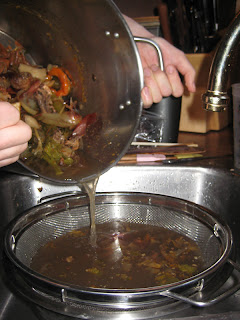
Never underestimate the value of volunteers. With the seasonal clock ticking and no-till methods at the forefront, we had to get a move on prepping our row crop area. For two people, this would have been a daunting task. For
sixteen, no problem.
I love planning events, so a farm workday was a treat to brainstorm. There was plenty of work to do and coordinating two meals with no electricity or running water was a delightful challenge. In many ways, planning for Saturday was like a mini remix of our wedding weekend (minus the white dress), so it was a piece of cake. Two weeks out, menus were planned, supplies were ordered and invites were sent.
RSVP's rolled in immediately and soon we had twice the response we anticipated. Food prep was going smoothly and packages were arriving at the house daily. What could possibly go wrong?
Two days out, the rains came. Then the ice. Temperatures plummeted. Cancellations started trickling in from those who had RSVP'd. The fabric mulch - a critical part of the rows we were to create - was delayed and wouldn't arrive on time. We readjusted our expectations for the day and took comfort in the sunny 55 degree forecast for Saturday.
Saturday arrived after a rather pleasant Friday, and our hopes were refreshed. With the truck and the car loaded, we left Little Rock with one extra passenger. In Conway we met up with another car - a girl from my roller derby team and two of her friends. Once on the farm, we unloaded the truck in a hurry so that Mike could make it to the feed store before it closed at noon. Another friend arrived and lunch was served - curry chicken salad with grapes, local egg salad with cilantro, creamy potato salad, hot baked beans, bread, lettuce from the cold frame, homemade fig newtons, peanut butter balls and a dozen mason jars with an assortment of jams and pickled things. Everything made from scratch with as many local ingredients as possible. Even if the day was miserable, we were going to eat well.
Just as I was feeling frustrated that I had forgotten the pies and mentally calculating what seven of us could accomplish, Mike returned with a load of straw bales and three cars in tow full of volunteers from the Heifer Ranch in Perryville. In an instant, our numbers more than doubled. Everyone cheered and the workday began.
We removed the manure from the front porch slab and transported it to the garden areas in truck loads. Here it was mixed with compost and soil from home and then spread out to mark seven 150 ft beds. We added a layer of newspaper under the compost since we didn't have the mulch fabric to place on top just yet. Instead, we covered the rows with a thick layer of straw. On the next workday we'll lay the drip tape, put down the biodegradable mulch with fabric staples and move the straw on top of it all. A slight glitch in plans, but we feel confident that it will work out alright.

A crew of people cleaned up around the farmhouse: chainsawing trees, picking up branches and making piles of scrap metal and stones for future use. A couple people tended to the pork shoulder which spent the day in the smoker in prep for supper and many cameras circulated the property capturing proof of the day. Progress was made digging down to the water main in prep for an outdoor water spigot to be installed and we were happy to discover 70 ft of water in the property's main well. Mike's grandfather was a well-driller, so there are several wells on the property to explore.
Other successes of the day included spraying the land with a worm tea mixture in an attempt to decrease the acidity levels in the soil, broadcasting a variety of seeds and seed balls, moving an enormous cast iron bathtub full of worms over to the covered porch area (it took all of us to lift it), and forging some very flooded areas in the truck in order to retrieve a load of sandy clay for a future cobbing project.
A good time was had by all - even those who didn't participate in manure flinging fights or rolling down the hill in a rain barrel. As the sun set, we gathered around a campfire which provided warmth, a place to burn ample amounts of wood, a surface to heat apple cider, and coals for cooking foil packets of seasoned vegetables to compliment our pulled pork sandwiches.

My heart was glowing as I relaxed in my camp chair looking around the circle at all these amazing, like-minded people. They are more than volunteers, more than just friends...we are
partners in creating a more hopeful, healthy, sustainable future. We are the ideas, the hands, the energy and the support system. We can make great things happen.
After the last car pulled out of the driveway, Mike and I sat by the fire as the embers burned low. I took a stroll down to the garden area and lingered between the rows of golden straw glimmering in the moonlight. The transformation was like magic. Though the vision in my head may be 20 years in the making, this land already feels like home.
For photos of the workday,
CLICK HERE!









.JPG)





.JPG)



.JPG)
.JPG)














.jpg)


.jpg)
.jpg)
.jpg)
.jpg)

.jpg)





